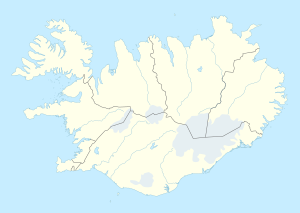Nesjavellir power plant
| Nesjavellir power plant | |||
|---|---|---|---|
| Aerial view of the Nesjavellir power plant | |||
| location | |||
|
|
|||
| Coordinates | 64 ° 6 '26 " N , 21 ° 15' 39" W | ||
| country | Iceland | ||
| Data | |||
| Type | Geothermal power plant | ||
| Primary energy | Geothermal energy | ||
| power | 120 megawatts electrical 300 megawatts thermal |
||
| Start of operations | 1990 | ||
The Nesjavellir Power Plant ( isl . : Nesjavallavirkjun ) is the largest geothermal power plant in Iceland . It is located in the southwest of the island near Þingvellir and the Hengill volcano .
Construction history and performance of the power plant
Construction began in 1987 and the foundation stone of the power plant was laid on May 13, 1990, after extensive explorations of the geothermal conditions had taken place in the two decades before. On September 29, 1990, the power plant of the semi-public company Orkuveita Reykjavíkur started operations.
In the first phase, the power plant with 4 boreholes from 1000 to 2000 m depth produced around 100 MW of total output with around 560 liters per second of hot water. In 1995 a fifth well was commissioned and capacity increased to 150 MW with 840 liters per second of hot water. In 1998 two steam turbines were put into operation and in June 2001 a third, with a total production of 90 MW electrical energy. Gradually, 5 more boreholes were developed and the total capacity increased to 200 MW with more than 1100 liters per second of hot water.
The current output of the power plant is 120 MW of electrical energy and 300 MW of thermal energy, corresponding to around 1800 liters of hot water per second. The power plant has thus achieved its targeted maximum output of around 400 MW.
It is estimated that the geothermal energy of the region is sufficient to operate the power plant with this total output for about 30 years. After that, Nesjavellir's energy production will decrease. In order to continue to meet the energy needs of the Reykjavík region in the future, further test drilling is being undertaken in the Hengill region.
Since 2008, another, even larger power plant from the same operator has been using the energy of the Hengill area, the Hellisheiði power plant .
In the region of Kolviðarhóll and Ölfusvatn in particular , further geothermal resources are suspected.
building-costs
According to the operator ( Orkuveita Reykjavíkur ), the construction costs of the power plant in 1998 prices were as follows:
- Research and drilling US $ 32.9 million
- Construction phase 1, up to a capacity of 100 MW, US $ 45.9 million
- Construction phase 2, expansion to capacity 150 MW 7 million US $
- Construction phase 3, expansion to a capacity of 200 MW and 60 MW electrical energy (estimated) US $ 55 million
- Main pipeline to Reykjavík US $ 41.5 million
- High voltage line to Reykjavík (estimated) US $ 7 million
See also
Sources and web links
- Commons : Nesjavellir Power Plant - Collection of Images
- Detailed description of the power plant (English, pdf; 1.79 MB)
- Website the power plant operator with technical information (English)



